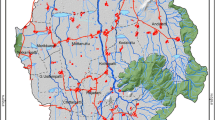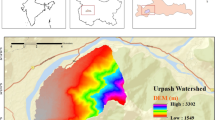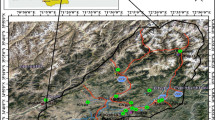Abstract
Soil erosion is a serious problem mankind is facing today as it has been continuously degrading the quality and standard of lives across the globe. Being a hilly country with undulating topography with steeper slopes accompanied with heavy rainfall, Nepal is predisposed to natural hazards including soil erosion. This paper attempts to model the soil erosion rate in the Aringale Khola Watershed of middle hills of Nepal with the judicious use of geographic information system (GIS) and revised universal soil loss equation (RUSLE) techniques. RUSLE was used in ArcGIS environment, taking rainfall-runoff (R), soil erodibility (K), topography (LS), crop management (C) and conservation support practice (P) factors as primary inputs. A total of nine soil erosion classes were observed; soil erosion rates ranging from 0.03 to 100.33 t/ha/year with a mean soil rate of 11.17 t/ha/year. GIS analysis depicted that 36.93% (1256.28 ha) of the total watershed area fell in the severe erosion classes whereas the remaining 63.07% (2145.56 ha) were less severe. A major part of the watershed, particularly areas with higher elevations and steep slopes, are degraded and needs urgent conservation measures. This study is a first attempt to model soil erosion distribution in the Aringale Khola Watershed and has very good potential to be used for soil erosion prediction in similar watersheds in the middle hills of Nepal.




Similar content being viewed by others
References
Abdo H, Salloum J (2017) Mapping the soil loss in Marqya basin: Syria using RUSLE model in GIS and RS techniques. Environ Earth Sci 76:114
Atreya K, Sharma S, Bajracharya RM, Rajbhandari NP (2006) Applications of reduced tillage in hills of central. Nepal Soil Tillage Res 88:16–29
Awasthi K, Sitaula B, Singh B, Bajacharaya R (2002) Land-use change in two Nepalese watersheds: GIS and geomorphometric analysis Land. Degrad Dev 13:495–513
Bahadur KK (2009) Mapping soil erosion susceptibility using remote sensing and GIS: a case of the Upper Nam Wa Watershed, Nan Province. Thail Environ Geol 57:695–705
Bahrawi JA, Elhag M, Aldhebiani AY, Galal HK, Hegazy AK, Alghailani E (2016) Soil erosion estimation using remote sensing techniques in Wadi Yalamlam Basin, Saudi Arabia. Adv Mater Sci Eng 2016:1–8
Bouyoucos GJ (1962) Hydrometer method improved for making particle size analyses of soils. Agron J 54:464–465
Carlson TN, Ripley DA (1997) On the relation between NDVI, fractional vegetation cover, and leaf area index. Remote Sens Environ 62:241–252
Chalise S, Khanal N (1997) Erosion processes and their implications in sustainable management of watersheds in Nepal Himalayas. IAHS Publication, Wallingford, pp 325–334
Chalise D, Kumar L (2018) Land use change impacts on soil erosion dynamics in western Nepal. University of New England, Armidale
Chalise D, Kumar L, Sharma R (2017) Impacts of land degradation in the middle hills of Nepal. National Maize Research Programme, Rampur
Dabral P, Baithuri N, Pandey A (2008) Soil erosion assessment in a hilly catchment of North Eastern India using USLE, GIS and remote sensing. Water Resour Manag 22:1783–1798
De Jong SM (1994) Derivation of vegetative variables from a Landsat TM image for modelling soil erosion. Earth Surf Proc Land 19:165–178
Farhan Y, Zregat D, Farhan I (2013) Spatial estimation of soil erosion risk using RUSLE approach, RS, and GIS techniques: a case study of Kufranja watershed. North Jordan J Water Resour Prot 5:1247
Fort M, Cossart E, Arnaud-Fassetta G (2010) Hillslope-channel coupling in the Nepal Himalayas and threat to man-made structures: the middle Kali Gandaki Valley. Geomorphology 124:178–199
Ganasri B, Ramesh H (2016) Assessment of soil erosion by RUSLE model using remote sensing and GIS-A case study of Nethravathi Basin. Geosci Front 7:953–961
Ghimire SK, Higaki D, Bhattarai TP (2013) Estimation of soil erosion rates and eroded sediment in a degraded catchment of the Siwalik Hills, Nepal. Land 2:370–391
Harper D (1987) Improving the accuracy of the universal soil loss equation in Thailand. In: fifth international conservation conferences, Bangkok, Thailand
Higaki D, Karki KK, Gautam CS (2005) Soil erosion control measures on degraded sloping lands: a case study in Midlands of Nepal. Aquat Ecosyst Health Manag 8:243–249
Jasinski MF (1990) Sensitivity of the normalized difference vegetation index to subpixel canopy cover, soil albedo, and pixel scale. Remote Sens Environ 32:169–187
Joshi AR, Shrestha SL, Joshi K (2003) Environmental management and sustainable development at the crossroad. AnKuS, p 302
Jung H, Jeon S, Lee D (2004) Development of soil water erosion module using GIS and RUSLE. In: The 9th Asia-Pacific integrated model (AIM) international workshop, pp 12–13
Karaburun A (2010) Estimation of C factor for soil erosion modeling using NDVI in Buyukcekmece watershed Ozean. J Appl Sci 3:77–85
Karkee K (2004) Land degradation in Nepal: a menace to economy and ecosystems. Lund University, Sweden
Ligonja P, Shrestha R (2015) Soil erosion assessment in kondoa eroded area in Tanzania using universal soil loss equation geographic information systems socioeconomic approach. Land Degrad Dev 26:367–379
Lu H, Prosser IP, Moran CJ, Gallant JC, Priestley G, Stevenson JG (2003) Predicting sheetwash and rill erosion over the Australian continent. Soil Res 41:1037–1062
Lu D, Li G, Valladares GS, Batistella M Land (2004) Mapping soil erosion risk in Rondonia, Brazilian Amazonia: using RUSLE, remote sensing and GIS. Degrad Dev 15:499–512
Millward AA, Mersey JE (1999) Adapting the RUSLE to model soil erosion potential in a mountainous tropical watershed. Catena 38:109–129
Mohammad AG, Adam MA (2010) The impact of vegetative cover type on runoff and soil erosion under different land uses. Catena 81:97–103
Morgan RPC (2009) Soil erosion and conservation. Wiley, Hoboken
Nigel R, Rughooputh SD (2013) Application of a RUSLE-based soil erosion modelling on Mauritius Island. Soil Res 50:645–651
Nyssen J, Poesen J, Deckers J (2009) Land degradation and soil and water conservation in tropical highlands. Soil Tillage Res 103:197–202
Partap T, Watson HR (1994) Sloping agricultural land technology (SALT): a regenerative option for sustainable mountain farming. International Center for Integrated Mountain Development (ICIMOD), Kathmandu
Prasannakumar V, Shiny R, Geetha N, Vijith H (2011) Spatial prediction of soil erosion risk by remote sensing, GIS and RUSLE approach: a case study of Siruvani river watershed in Attapady valley, Kerala, India. Environ Earth Sci 64:965–972
Renard KG, Foster GR, Weesies GA, Porter JP (1991) RUSLE: revised universal soil loss equation. J Soil Water Conserv 46:30–33
Renard K, Foster G, Yoder D, McCool D (1994) RUSLE revisited: status, questions, answers, and the future. J Soil Water Conserv 49:213–220
Renard KG, Foster GR, Weesies G, McCool D, Yoder D (1997) Predicting soil erosion by water: a guide to conservation planning with the Revised Universal Soil Loss Equation (RUSLE), vol 703. US Government Printing Office, Washington, DC
Shrestha DP (1997) Assessment of soil erosion in the Nepalese Himalaya: a case study in Likhu Khola Valley, Middle Mountain Region. Land Husb 2:59–80
Shrestha AB, Aryal R (2011) Climate change in Nepal and its impact on Himalayan glaciers. Reg Environ Change 11:65–77
Shrestha D, Zinck J, Van Ranst E (2004) Modelling land degradation in the Nepalese Himalaya. Catena 57:135–156
Simms A, Woodroffe C, Jones B (2003) Application of RUSLE for erosion management in a coastal catchment, southern NSW. Paper presented at the International Congress on Modelling and Simulation, Townsville, Queensland
Tesfahunegn GB, Tamene L, Vlek PL (2014) Soil erosion prediction using Morgan-Morgan-Finney model in a GIS environment in Northern Ethiopia catchment. Appl Environ Soil Sci 2014:1–15
Tiruwa DB (2016) Soil erosion assessment using geographical information system and revised universal soil loss equation at Deurali VDC, Nawalparasi. Agriculture and Forestry University, Bharatpur
Uddin K, Murthy M, Wahid SM, Matin MA (2016) Estimation of soil erosion dynamics in the Koshi basin using GIS and remote sensing to assess priority areas for conservation. PLoS One 11:e0150494
Upadhayay HR et al (2018) Community managed forests dominate the catchment sediment cascade in the mid-hills of Nepal: a compound-specific stable isotope analysis. Sci Total Environ 637:306–317
Upanoi T, Tripathi NK (2003) A satellite based monitoring of changes in mangroves in Krabi, Thailand. In: Proceedings of the map Asia conference, pp 1–10
Vásquez-Méndez R, Ventura-Ramos E, Oleschko K, Hernández-Sandoval L, Parrot J-F, Nearing MA (2010) Soil erosion and runoff in different vegetation patches from semiarid Central Mexico. Catena 80:162–169
Walkley AJ, Black IA (1934) Estimation of soil organic carbon by the chromic titration method. Soil Sci 37:29–38
Wall G, Coote D, Pringle E, Shelton I (2002) RUSLEFAC—revised universal soil loss equation for application in Canada: a handbook for estimating soil loss from water erosion in Canada Research Branch, Agriculture and Agri-Food Canada Ottawa Contribution No AAFC/AAC2244E 117
Wang G, Gertner G, Fang S, Anderson AB (2003) Mapping multiple variables for predicting soil loss by geostatistical methods with TM images and a slope map. Photogramm Eng Remote Sens 69:889–898
Wijesekera S, Samarakoon L (2001) Extraction of parameters and modelling soil erosion using GIS in a grid environment. In: Asian conference on remote sensing, (5–9 September), Singapore
Wischmeier WH, Smith DD (1978) Predicting rainfall erosion losses-a guide to conservation planning. Predict Rainfall Eros Losses Guide Conserv Plan
Yang X (2015) Digital mapping of RUSLE slope length and steepness factor across New South Wales, Australia. Soil Res 53:216–225
Yoon K, Kim C-W, Woo H (2009) Application of RUSLE for erosion estimation of construction sites in coastal catchments. J Coast Res 2:1696–1700
Yue-Qing X, Xiao-Mei S, Xiang-Bin K, Jian P, Yun-Long C (2008) Adapting the RUSLE and GIS to model soil erosion risk in a mountains karst watershed, Guizhou Province, China. Environ Monit Assess 141:275–286
Zhou ZC, Shangguan ZP, Zhao D (2006) Modeling vegetation coverage and soil erosion in the Loess Plateau Area of China. Ecol Model 198:263–268
Acknowledgements
Devraj Chalise conducted this study as a part of his PhD research funded by International Postgraduate Research Award provided by University of New England under the guidance of Lalit Kumar. Chandeshwar Prasad Shriwastav and Sushil Lamichhane also reviewed the manuscript. We would also like to thank anonymous reviewers and editors to bring this manuscript in this shape.
Author information
Authors and Affiliations
Corresponding author
Rights and permissions
About this article
Cite this article
Chalise, D., Kumar, L., Shriwastav, C.P. et al. Spatial assessment of soil erosion in a hilly watershed of Western Nepal. Environ Earth Sci 77, 685 (2018). https://doi.org/10.1007/s12665-018-7842-3
Received:
Accepted:
Published:
DOI: https://doi.org/10.1007/s12665-018-7842-3




